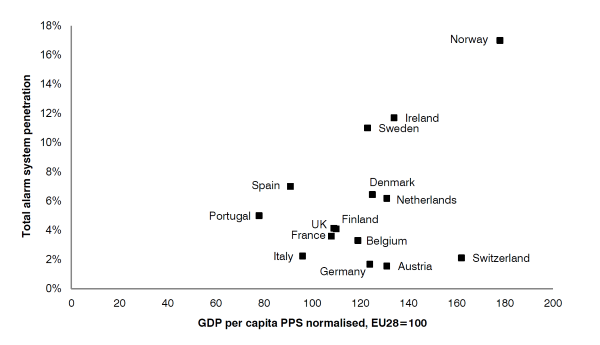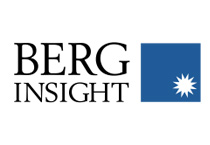Over the last few months Berg Insight has been looking closely at the monitored alarm systems market. According to the upcoming new research report by Berg Insight to be published in April, the number of monitored alarm systems in Europe is forecasted to grow from 8.7 million in 2016 at a compound annual growth rate (CAGR) of 4.0 percent to reach 10.6 million in 2021.
In North America, the number of monitored alarm systems is forecasted to grow at a CAGR of 2.9 percent from 32.1 million at the end of 2016 to 37.1 million at the end of 2021. Small alarm systems for businesses and private homes can be divided into two main categories – local alarms and monitored alarms. The simplest type of local alarm only reacts to activation by ringing bells to alert the surroundings and scare off intruders. A more advanced type of local alarm is a self-monitoring alarm. Upon activation, this type of alarm informs the owner of the premises by sending a text message or push notification. Monitored alarms are connected to an Alarm Receiving Centre (ARC) that can respond to an activated alarm by contacting the police or dispatching a security patrol.
ADT is the leading provider of monitored alarm systems in North America. In 2016, ADT merged with the competitor Protection 1, which will make the combined company the very clear leader with a 30 percent market share in the North American security alarm monitoring industry. Vivint and Monitronics are other players with well over a million monitored alarms. Comcast and Slomin’s are two other major actors on the very fragmented North American market. Verisure is the leading player on the European market, with monitored alarms in a dozen countries. The Sweden-based company is today a leading market player in several countries and the second position on the European market is held by Johnson Controls, which acquired Tyco in 2016. Securitas, G4S and the rising star Sector Alarm are all pretty big players, especially in the northern part of Europe. In the southern part, Prosegur and EPS are two dominant players. United Technologies Corporation with its Climate, Controls & Security business as well as Stanley Security are also important players active in both Europe and North America.
The installed base and penetration of alarm systems varies significantly between countries in Europe. Interestingly, there is little correlation between crime rate and alarm system penetration. However, a correlation between GDP and the demand for alarm monitoring services is apparent as Norway, Ireland and Sweden have the highest penetration figures in Europe measuring about 17 percent, 12 percent and 11 percent respectively. Denmark, the Netherlands and Spain also have penetration figures above 6 percent. In Central and Eastern Europe, which has much lower GDP per capita than Western Europe, the alarm system penetration is less than 1 percent in the residential market. Penetration of monitored alarm systems is much higher among households that live in detached and semi-detached houses than among households that live in apartments.
Figure 1: GDP per capita and total alarm system penetration (Europe 2016)

There is still a significant growth potential for monitored small alarm systems, especially in Europe where the total penetration reached only 3.7 percent of all businesses and households at the end of 2016. “The penetration of monitored alarm systems in North America is much higher than in Europe and the corresponding figure was in this region 22.0 percent at the end of 2016”, says Anders Frick, Senior Analyst at Berg Insight. Important drivers for increasing adoption of monitored alarm systems in the residential segment include economic development, the level of homeownership, as well as new home construction activity. However, the most important factor for market growth today is active marketing and sales led by specialist alarm service companies and new market entrants from the home automation industry. “Alarm systems are becoming more valuable for customers as the scope of offerings are being expanded to include detection of fire, carbon monoxide and water leaks, as well as home automation features such as smart plugs, locks, cameras, lighting and thermostat control”, concluded Mr Frick.










